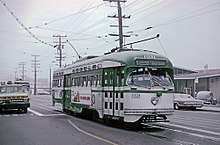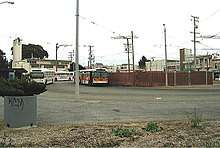Ocean and Lee station
|
Inbound train at Ocean and Lee in January 2018 | |||||||||||
| Location |
Ocean Avenue at Lee Avenue San Francisco, California | ||||||||||
| Coordinates | 37°43′25″N 122°27′15″W / 37.72349°N 122.45410°WCoordinates: 37°43′25″N 122°27′15″W / 37.72349°N 122.45410°W | ||||||||||
| Owned by | Muni | ||||||||||
| Line(s) | |||||||||||
| Platforms | 2 side platforms | ||||||||||
| Connections |
| ||||||||||
| Construction | |||||||||||
| Disabled access | Yes | ||||||||||
| History | |||||||||||
| Opened | December 4, 1895 | ||||||||||
| Services | |||||||||||
| |||||||||||
Ocean and Lee is a light rail stop on the Muni Metro K Ingleside line, located between the Westwood Park and Ingleside neighborhoods of San Francisco, California. The stop consists of two side platforms, with the eastbound (outbound) platform located on Ocean Avenue west of the intersection with Lee Street, and vice versa. It originally opened in 1895 on the United Railroads 12 line; K Ingleside service began in 1945.
History


The private Market Street Railway opened a branch - built in just six days - of its Mission Street line along Ocean Avenue to Victoria Street on December 4, 1895 to serve the new Ingleside Racetrack.[1] The line was extended to the Ingleside House (where Ocean Avenue now meets Junipero Serra Boulevard) shortly thereafter.[2] The 1906 earthquake damaged many cable car and streetcar lines; the URR resumed service on the Ocean Avenue (12) line on May 6, 1906.[3]
On November 25, 1918, the city and the struggling URR signed the "Parkside Agreements", which allowed Muni streetcars to use URR trackage on Junipero Serra Boulevard, Ocean Avenue, and Taraval Street, in exchange for a cash payment and shared maintenance costs.[4] The K Ingleside line was extended south on Junipero Serra Boulevard and east on Ocean to Ocean and Miramar on February 21, 1919. Miramar was the terminus of the line until May 18, 1919, when it was extended east on Ocean Avene and south on Brighton Avenue to Grafton Avenue.[3]
The city purchased the private company (renamed Market Street Railway in 1921) in 1944; route 12 service was removed from Ocean Avenue on April 8, 1945, leaving just the K Ingleside.[3] On April 8, 1945, route 12 service was removed from Ocean Avenue, while every other K Ingleside car was extended on Ocean Avenue and Onondaga Street to Mission Street to provide a direction connection to route 14.[3] In 1952, Muni constructed a loop for the K with a separate busway for the 12 (converted to bus in 1948) on city property north of Ocean Avenue and west of Phelan Avenue, adjacent to the then-new City College.[4] The Brighton Avenue trackage was retired and replaced with the new Phelan Loop on May 18, 1952; the alternate service to Mission Street was cut back to the loop on October 10, 1952.[3]
In the 1970s, Muni rebuilt the non-revenue trackage for regular service so that K Ingleside service could be extended to the new Balboa Park station. The first revenue service to Balboa Park was on April 23, 1979, although service past Phelan Loop did not run at all times until March 17, 1981. Phelan Loop was then retired for streetcar service, replaced with platforms on Ocean Avenue at Lee Street.[3] However, Muni buses continued using the bus loop because Balboa Park station did not include a bus terminal. By the early 2000s, the loop was part of a section of Ocean Avenue deemed "bleak and uninteresting", in contrast to the commercial district to the west.[5] In 2001, as part of a planning process for the Balboa Park area, the city proposed to build a housing development and public open space on the loop parcel, with buses using a new loop behind an adjacent fire station closer to Phelan Avenue.[6]
The line was closed and replaced by buses from February 2001 to June 7, 2003 for the Ocean Avenue Reconstruction and Improvement Project, a major street repaving and utility replacement project. Muni boarding islands were reconstructed at the stations along Ocean Avenue, with new accessible platforms built at Ocean and Lee.[7] In July 2010, Muni received a $6.8 million federal grant to fund the loop relocation.[8] The new loop opened on May 6, 2013 as the terminal for the 8/8BX and 49 routes, which enter the loop from Ocean Avenue and exit onto Phelan Avenue.[9] Housing was soon built on the old loop site; the new open space, Unity Plaza, opened next to the loop in October 2016.[10]
References
- ↑ Rice, Walter; Echeverria, Emiliano (2002). When Steam Ran on the Streets of San Francisco. Harold E. Cox. p. 66.
- ↑ Southern Pacific Company (1897). "Guide Map Of The City of San Francisco". H.S. Crocker Co. – via David Rumsey Map Collection.
- 1 2 3 4 5 6 Stindt, Fred A. (October 1990). San Francisco's Century of Street Cars. pp. 94, 189. ISBN 0961546514.
- 1 2 Perles, Anthony (1981). The People's Railway: The History of the Municipal Railway of San Francisco. Interurban Press. pp. 74, 168, 188. ISBN 0916374424.
- ↑ "Chapter 2: Background". Balboa Park Station Area Plan (Draft for Public review) (PDF). San Francisco Planning Department. October 2002. p. 19.
- ↑ "Balboa Park Station: Workshop #4, Summary of Proposed Plan Concepts and Public Input". San Francisco Planning Department. September 2001.
- ↑ "Grand Re-Opening of Ocean Avenue Celebrated" (Press release). San Francisco Municipal Railway. June 20, 2003. Archived from the original on December 5, 2004.
- ↑ "SFMTA Awarded $6.8 Million in Federal Capital Funds For Phelan Loop Project" (Press release). City and County of San Francisco Office of the Mayor. July 9, 2010. Archived from the original on September 3, 2010.
- ↑ "Reconfigured Muni Phelan Loop Bus Terminal Facilitates Community Development" (Press release). San Francisco Municipal Transportation Agency. May 3, 2013.
- ↑ "Unity Plaza". San Francisco Municipal Transportation Agency.
External links
| Wikimedia Commons has media related to Ocean and Lee station. |
- SFMTA - Ocean Ave & Lee St inbound and outbound
- SFBay Transit (unofficial) - Ocean Ave & Lee St